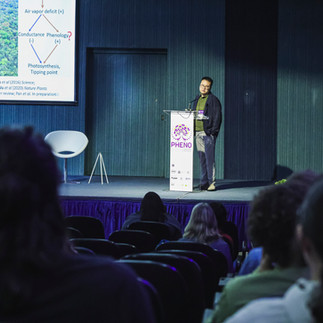Jin Wu presents a lecture on connecting individual trees to regional scales
- cbioclimamidia

- Jul 29
- 1 min read
By Emerson José
Jin Wu, from the University of Hong Kong, explores in his presentation at PHENO 2025 the critical role of fine-scale phenology variability in understanding forest ecosystems and their responses to climate change. The presentation highlights innovative remote sensing (RS) technologies to bridge the observational gaps between individual trees and regional scales.
These are the Key Points from his research:
Phenology’s Global Significance:
Phenology (seasonal biological events) impacts climate change adaptation, agricultural management, trophic interactions, and carbon/water cycles.
Tropical "evergreen" forests exhibit cryptic phenology, where individual tree dynamics (e.g., leaf age) drive ecosystem productivity (GPP seasonality).
Observational Dilemma:
Ground-based methods (e.g., PhenoCams, drones) offer high resolution but limited coverage.
Satellite data (e.g., MODIS) provide broad coverage but lack fine-scale detail.
Solution: PlanetScope (3m resolution, daily imagery since 2018) bridges this gap, enabling individual tree phenology monitoring at landscape scales.
Case Studies:
Temperate Forests:
At Mt. Changbai (China), PlanetScope validated crown-scale autumn phenology (Start/End of Leaf Fall) with ground data (*r* = 0.94).
NEON data showed biotic traits (e.g., biomass distribution) explain 3× more phenological variability than plant functional types (PFTs).
Tropical Forests:
Amazonian forests display unexpected deciduousness, challenging "evergreen" assumptions.
Spectral unmixing of PlanetScope data revealed leafless canopy abundance, improving GPP models and tipping point predictions.
Innovations & Implications:
High-throughput trait mapping: Sentinel-2 and airborne hyperspectral data enable continental-scale trait analysis (e.g., LMA) to link phenology with climate resilience.
Amazon’s Tipping Points: Phenological shifts (e.g., dry-season leaf turnover) are critical indicators of ecosystem collapse under warming.
Future Directions:
Scaling individual-level observations to ecosystem models.
Enhancing RS techniques (e.g., cross-sensor calibration, cloud gap-filling) for global phenology monitoring.





































Comments